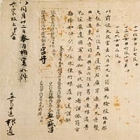Japanese Archaeology and Special Exhibition (Heiseikan) Thematic Exhibition Room
September 13, 2016 (Tue) - November 6, 2016 (Sun)
Japanese hand-made paper, or Washi, was listed as a UNESCO intangible cultural heritage in November 2014. The nomination was based on a nationwide survey about the production of major varieties, held during the fiscal years 1953 to 1966. Items related to this survey are now in the Tokyo National Museum collection. This exhibition features papers including Echizen hosho by Iwano Ichibei VIII, who was a Living National Treasure, and ganpi paper by Abe Eishiro, together with writing paper from Sekishu (sekishu banshi) of Shimane, and paper from Mino (hon minoshi) of Gifu, registered on the UNESCO list. Raw materials and papermaking tools are also on display, as well as written references, including The Illustrated Guide to Processing Mulberry by an official painter of the Tsuwano domain during the Edo period, and The Illustrated Guide to Echizen Papermaking, made for exhibiting at the Vienna World Exposition of 1873.
Paper used for written works from the Nara to the Edo period (8th to 19th century) are also notable. For example, Governor's Report on a Survey of Farmland Donated to Todaiji demonstrate papermaking techniques in the Nara period (710–794), the Certificate of Ordainment to Enchin suggests production within an official papermaking department in the court, and Gunjo chiyo displays a typical 11th-century example of poem writing paper. Ishiyamagire shows the ultimate sophistication of Washi making, and Fujiwara no Teika’s Letter of Entreaty employs sturdy danshi paper widely used in the medieval times. Through the development of writing paper, this exhibit looks into the sturdiness, flexibility, and whiteness of Washi, its charm, and the craftsmanship now recognized worldwide.

